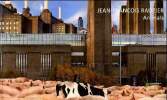2 books for « rauzier jean francois »Edit
-
Topics
Cinema (1)
Naturalist (1)
Painting (1)
Photography (2)
-
Countries
Belgium (1)
France (1)
-
Syndicate
ILAB (1)
SLAM (1)
Animals
Bailly contemporain. Février 2011. In-4. Broché. Très bon état, Couv. convenable, Dos satisfaisant, Intérieur frais. 40 pages environ augmentées de nombreuses photos en couleurs hors texte.. . . A l'italienne. Classification Dewey : 770-Photographie
Préface de Sausset Damien. Classification Dewey : 770-Photographie
Gabriel P. Weisberg, Edwin Becker, Maartje de Haan, David Jackson, Willa Silvermanand and Jean-Francois Rauzier;
Reference : 26356
Illusions of Reality: Naturalist Painting, Photography and Cinema, 1875-1918,
Brussels, Fonds Mercator, 2010 Hardcover with dust-jacket, 25,1 x 30,1 cm, 224pp., 226 colour illustrations, of which 90 full pages. ISBN 9789061539414.
Capturing realistic images on canvas has been a staple of western art since the renaissance development of scientific perspective. At the end of the nineteenth century, however, artists attempted not only to paint realistically, but also to create images that reflected the reality of the world around them. Naturalist painters portrayed life as they observed it, utilizing their academic artistic training to illustrate the existence of everyday people. Illusions of Reality: Naturalist Painting, Photography and Cinema, 1875-1918, published in association with an eponymous exhibition developed by the Van Gogh Museum in Amsterdam, traces the relationship between several art forms that utilize the Naturalist aesthetic. Painting, literature, theatre, photography and film, and the important relationship between these art forms, are examined within the context of Naturalism as a vehicle for understanding the lives of ordinary people at a time of great social, economic and cultural transformation. The cultural and technological threads that wove these diverse art forms together emerged earlier in the nineteenth century with the development of photography. In the 1840, painters began to experiment with the use of the camera as a tool for composition, and by the 1870s, Naturalists novelists, such as Emile Zola, recognized that the camera could supplement their written notes in documenting scenes from daily life. Likewise, the theatre became more receptive to producing plays about social and cultural concerns, broadening the repertoire to include dramas based on contemporary issues. The advent of film in the late nineteenth century added yet another dimension to the Naturalist aesthetic, basing this new art form on the models provided by large-scale narrative painting, Naturalist photography, and contemporary, socially conscious theatre productions. In a series of essays, the authors of Illusions of Reality: Naturalist Painting, Photography and Cinema, 1875-1918 explore the international scope of Naturalism through a number of interwoven themes. The livres of ordinary people are at the heart of Naturalist art in any medium, and so the themes of these works reflect the common concerns shared by urban an rural populations in both Europe and North America. The social ills created by industrialization are frequent themes, as are the social responses to these problems in the form of public education and newly energized religious faith. Likewise, the transformation brought about by industrialization led many artists to focus on the loss of traditional agrarian culture as well as the political upheaval caused by working conditions in the factories. In short, Illusions of Reality: Naturalist Painting, Photography and Cinema, 1875-1918 offers a fresh interpretation of how Naturalist artists, and the aesthetic the espoused, attempted to understand and explain the rapid and profound changes of their own time. Accompanies the exhibitions in the Van Gogh Museum Amsterdam, 8 October 2010 - 16 January 2011, and in the Ateneum Art Museum, Helsinki, February - June 2011.
 Write to the booksellers
Write to the booksellers



